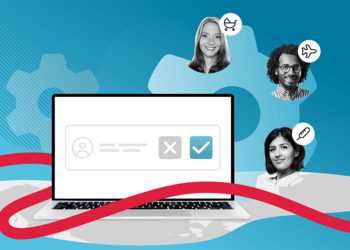Employee Onboarding: Best Practices and Main Phases

What Is Employee Onboarding?
Employee onboarding is the process of introducing new employees to a company. Onboarding includes various types of activities that help new hires get up to speed with how the company runs, including:
- Team and company structure
- Vision
- Culture and values
- Business mission and objectives
Employee onboarding programs are designed to help the latest staff members adjust to their new work environment and duties as quickly and as efficiently as possible.
- What Does the Onboarding Process Look Like?
- Why Is Employee Onboarding important?
- How Long Should Employee Onboarding Take?
- Employee Onboarding: Best Practices
- Employee Onboarding: 4 Main Phases
- Phase 1: Before New Employees Join Your Company
- Phase 2: First Day at Work
- Phase 3: First Week at Work
- Phase 4: After the First Week
- Main Takeaways
What Does the Onboarding Process Look Like?
The employee onboarding process is the exact way a specific company decides to approach onboarding. Most companies have a clearly defined step-by-step onboarding process that aims to help HR professionals, managers, or other team members get the new hires up to speed.
The employee onboarding process usually involves a sprint of tasks that aim to describe the company's procedures to new employees.
The typical tasks employees have to complete during onboarding include:
- Reviewing company policies, like safety procedures, various behavior protocols (office dress codes, etc.), attendance policy, and similar.
- Meeting new colleagues, team members, and any relevant stakeholders.
- Going through training on security protocols, specific processes or tools that the company uses, etc.
- Reading through different types of resources or materials that help employees get to know their new company (history, major business success, big milestones, etc.).
Why Is Employee Onboarding important?
Onboarding can significantly impact the employees’ long-term success at their new company and, consequently, the company’s success because the two are so closely intertwined.
Additionally, a paper by Madeline Laurano from the Brandon Hall Group shows that a good onboarding process can reduce turnover by a whopping 82%.
How Long Should Employee Onboarding Take?
The length of employee onboarding can depend on the specific role a new hire is being prepared for. But, for the most part, the initial period shouldn't take longer than four to eight weeks (or one to two months).
After that period passes, a new employee should be able to start working on their actual work tasks and producing value for their new company.
Employee Onboarding: Best Practices
There are certain things that can help you streamline the onboarding process.
- Creating a mission statement for employee onboarding — Think about the main ideas behind the onboarding process. What is your goal? What are the key things a new employee should take away from the onboarding? Establish guidelines that will inform how you approach creating each step of the employee onboarding process.
- Making sure responsibilities are clearly defined — What sort of responsibilities will the new employees have regarding time tracking? Do they need employee IDs and access cards? What sort of information should the new employees provide to HR for contractual or other purposes?
- Making a checklist of the necessary steps — Create a checklist for HR, managers, or team members that covers all the necessary administrative, technical, and other responsibilities for new employees.
- Automatization — Streamlining and automating HR processes, whenever possible, can save you a lot of time and can make onboarding easier and much quicker for you and new hires.
Employee Onboarding: 4 Main Phases
Phase 1: Before New Employees Join Your Company
The main goal of this phase is to help new employees settle into their new work environment as quickly as possible while also ensuring they feel comfortable. Some things that you should cover during this initial employee onboarding phase include:
Various Types of Formalities
Make sure contractual formalities, access rights, work uniforms, and similar are all taken care of in advance. Anything that new employees will need before they can start coming into work.
General Orientation Information
When and where should the new employee come to work? What are the basics of the job, and what should the new employee expect to encounter during the initial onboarding period?
You can share this information via email or a work messaging app (if your company uses one) so you leave a paper trail; just make sure to do it at least a week before the new employee is set to start working.
Team Members and Direct Coworkers
Every current employee who's directly involved in onboarding a new hire should have all the necessary information about the process (a sort of to-do list with all the tasks they are responsible for).
For example, IT personnel should know when to give new employees access to specific company software or tools. Also, it could be a good idea to set up a mentor for the new employee, or at least someone who will guide them during the first couple of days or weeks.
Training
Will the new employee require additional training in a specific area of their new job, and what type of training do they need? If the answer is yes, schedule training in advance and make it a part of the onboarding process.
Phase 2: First Day at Work
The first day at a new job is always extra stressful. Your goal at this stage of the employee onboarding process is to minimize that stress and make the new employee feel comfortable while slowly introducing them to their new duties.
To make sure everything goes smoothly on their first day, you should think about the following:
- Giving new employees an option to come into work an hour later than everybody else. This will spare them the usual “morning chaos”, but will also give you enough time to prepare for their arrival.
- Creating a welcoming culture from the moment new employees step foot into the company's premises. Offer to make or show them where to get coffee, snacks, breakfast, rest from work, and similar.
- Arranging an introductory meeting where new employees can introduce themselves to their new team members, other colleagues, and so on.
- Focusing on team bonding and ensuring that the new employee doesn't eat lunch alone. Although this can seem like a small thing, nobody likes eating lunch alone, especially on their first day. If you personally can’t attend lunch with them, try to get their new direct manager or new team members to invite them to lunch.
Phase 3: First Week at Work
This part of employee onboarding will not always go smoothly. Adjusting to new systems and processes can often be difficult. Consider doing the following things to help new employees adjust as quickly and easily as possible:
- Explain the onboarding process to the new employees and make sure every step is clearly defined. Leave some to answer questions from new hires.
- Set expectations as clearly as possible. New employees should review their responsibilities with their direct managers and should know what their tasks are for the first couple of weeks.
- Think about doing a company tour to familiarize new employees with different departments, the people who are in charge of those departments, and so on.
- Introduce new employees to the business by showing them a product or service presentation that your company offers.
- Share information about company goals and culture. Tell them about what sort of goals the company is aiming to achieve and how they can contribute to those goals. You can use this as a preamble to a discussion about your company's culture and the importance of team spirit.
Phase 4: After the First Week
The two main steps that you should never forget about during this phase are:
- Ask new employees about their first impressions — Get feedback from the new employees. Ask them about their feelings and overall impressions. Consider giving them an opportunity to share their thoughts about the onboarding process and if there is anything they would improve. Try to push them to give you honest answers, as that can help you improve your employee onboarding process in the future.
- Create a communication channel for any questions new employees might have — During the first week at their new job, new employees will most certainly have to process a lot of information. Make sure to create a communication channel where they can ask any questions and not feel judged. This is important to ensure they get accustomed to their new role and feel supported along the way.
Main Takeaways
Employee onboarding encompasses the entire process of introducing new employees to their new company and work duties. It covers everything from getting the new hires settled into their roles to ensuring they become accustomed to the company's culture and become productive staff members as soon as possible.
The process should last between 4-8 weeks, depending on the role a new hire is being prepared for. To ensure it goes smoothly, HR professionals should focus on the main ideas behind onboarding, going as far as creating an onboarding mission statement that includes all the main goals of the onboarding process, so that:
- New employees integrate into the company’s culture, their new teams, workflows, and similar
- New employees become productive as fast as possible
- New employees are given all the necessary training and resources they need to excel in their new roles
- The employee turnover rate is low because they’ve fostered a positive, inclusive, and team and improvement-oriented culture
- The communication channels for giving and receiving feedback are open for new hires
To make it easier to onboard new employees, increase productivity, and streamline various processes, many HR professionals turn to modern digital tools and technology.



